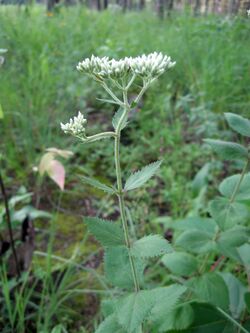Biology:Eupatorium rotundifolium
| Roundleaf thoroughwort | |
|---|---|

| |
| Scientific classification | |
| Kingdom: | Plantae |
| Clade: | Tracheophytes |
| Clade: | Angiosperms |
| Clade: | Eudicots |
| Clade: | Asterids |
| Order: | Asterales |
| Family: | Asteraceae |
| Genus: | Eupatorium |
| Species: | E. rotundifolium
|
| Binomial name | |
| Eupatorium rotundifolium | |
| Synonyms[2] | |
|
Synonymy
| |
Eupatorium rotundifolium, commonly called roundleaf thoroughwort, is a North American species of plant in the family Asteraceae. It native to the eastern and central United States , in all the coastal states from Maine to Texas , and inland as far as Missouri and the Ohio Valley.[3] It is found in low, moist habitats such as wet savannas and bogs.[4][5]
Description
The stems up to 100 cm (40 inches) tall and are produced from short rhizomes. The inflorescences are composed of a large number of small white flower heads, each with 5 disc florets but no ray florets. Plants can be highly variable due to hybridization.[4]
Taxonomy
Three varieties of Eupatorium rotundifolium are recognized. They are:[2]
- Eupatorium rotundifolium var. ovatum (Bigelow) Torr.
- Eupatorium rotundifolium var. rotundifolium
- Eupatorium rotundifolium var. scabridum (Elliott) A.Gray
The plants known as Eupatorium rotundifolium var. saundersii have often been treated as a variety of E. rotundifolium. They can be distinguished based on morphology,[6] and molecular evidence also suggests that these plants may be different enough from E. rotundifolium to recognize them as a species, Eupatorium pilosum.[7]
Hybridization
As is common in Eupatorium, E. rotundifolium can form hybrids with other species in the genus. In particular, Eupatorium godfreyanum is a hybrid of E. rotundifolium and Eupatorium sessilifolium.[7]
Chemical constituents
Eupatorium rotundifolium contains sesquiterpene lactones of the guaianolide type including euparotin acetate and eupachlorin acetate, both of which inhibit tumor growth in vitro when isolated from the plant.[8][9]
References
- ↑ "Eupatorium rotundifolium". NatureServe Explorer. NatureServe. http://www.natureserve.org/explorer/servlet/NatureServe?searchName=Eupatorium+rotundifolium.
- ↑ 2.0 2.1 The Plant List, Eupatorium rotundifolium L.
- ↑ Biota of North America Program 2014 county distribution map
- ↑ 4.0 4.1 Flora of North America, Eupatorium rotundifolium Linnaeus, 1753. Roundleaf thoroughwort
- ↑ Alan Weakley (2015). "Flora of the Southern and Mid-Atlantic States". http://www.herbarium.unc.edu/flora.htm.
- ↑ "18. Eupatorium pilosum Walter". http://www.efloras.org/florataxon.aspx?flora_id=1&taxon_id=250066742.
- ↑ 7.0 7.1 Kunsiri Chaw Siripun; Edward E. Schilling (2006). "Molecular confirmation of the hybrid origin of Eupatorium godfreyanum (Asteraceae)". American Journal of Botany 93 (2): 319–325. doi:10.3732/ajb.93.2.319. PMID 21646192.
- ↑ "Eupachlorin acetate, a novel chloro-sesquiterpenoid lactone tumor inhibitor from Eupatorium rotundifolium". Tetrahedron Lett. 9 (31): 3517–3520. June 1968. doi:10.1016/S0040-4039(01)99098-7. PMID 5649802.
- ↑ "The isolation and structural elucidation of euparotin acetate, a novel guaianolide tumor inhibitor from Eupatorium rotundifolium". J Am Chem Soc 89 (2): 465–466. 18 January 1967. doi:10.1021/ja00978a061. PMID 6031638.
Wikidata ☰ Q5409972 entry
 |



